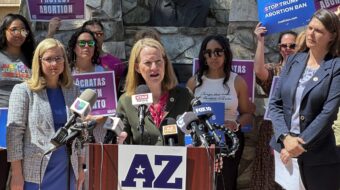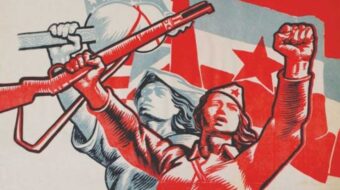Guatemalan prosecutors announced Jan. 26 that 85-year-old Efraín Ríos Montt, military dictator in 1982-1983, was going to trial in March. He’s accused of responsibility for killing and disappearing thousands of mostly poor and indigenous Guatemalans.
Gratified, blogger Juan José Guerrero wrote: “I was surgeon in the Coban Regional Hospital when you (Ríos Montt) were the de facto government leader. The cadavers that arrived at the morgue – when they arrived – seemed to have come out of a diabolical nightmare: women raped and pathologically tortured beforehand; children ripped open.”
A 36-year civil war ended in 1996 with peace accords signed both by the government and guerrilla insurgents known as Guatemalan National Revolutionary Unity (URNG). The war emerged out of chaos following CIA overthrow of an elected government in 1954 bent on mild land reform. Except during the Carter administration, U.S. support for the government side included military advisors, CIA operatives, military hardware, and funding. Both governments advanced the pretext of anti-communism.
The Guatemalan Conference of Bishops arranged for documentation of humanitarian catastrophe through the “Recovery of Historical Memory” (REMHI) project, led by Bishop Juan José Gerardi. The REMHI report “Guatemala: Nunca Mas,” (“Guatemala: Never Again”) issued on April 24, 1998, described eradication of 440 Mayan communities and the killing of 200,000 mostly unarmed, indigenous civilians. Blame fell largely upon the army and national government.
Efraín Ríos Montt is the first army leader called to account for war crimes. Impunity until now suggests the stage had been set with the peace agreement for traditional power brokers to go on with business as usual. Assassination of Bishop Gerardi by three army officers two days after release of the REMHI report set the tone, despite the jailing later on of the responsible officers.
Journalist Giorgio Trucchi‘s recent interview with former guerrilla leader Alba Estela Maldonado explored her view that people’s needs now go unmet due to continuing oppression. She discussed a new book containing testimonials from former guerrillas edited by fellow guerrilla leader Ricardo Ramírez de León. They say poverty, racism, and subjugation are still the rule.
During negotiations, Maldonado asserted, rebel leaders sought a settlement aimed at “changing the prevailing economic and political model.” While “the peace agreements constituted an important step in democratizing the country, [the] oligarchy took advantage of peace to introduce neoliberal policies…Basic reasons giving rise to the conflict are still intact.”
Maldonado cited a “strong wave of privatizations, land stolen and concentrated in a few hands, labor without regulation, and criminalization of social protest.” “Unregulated introduction of mono-crops like sugar and African palms, along with hydroelectric, mining, lumber, and petroleum megaprojects are examples…of new forms of domination.” Guatemala is “a leading agro-exporter,” says the U. K. Guardian. It boasts the largest GDP in Central America.
The Guatemalan oligarchy had earlier presided over wholesale slaughter. Now Guatemala confronts preventable, predictable deaths. Seemingly they are acceptable in ruling circles. Little regarded in political commentary, Guatemala’s maternal mortality rate (MMR) illustrates one way people die. MMR represents the number of women dying from pregnancy or birth-related causes per 100,000 births. Guatemala’s MMR, vying with that of Haiti as the highest in the Western Hemisphere, is now 290. Costa Rica’s MMR is 30. During four years of the recently concluded Álvaro Colom presidency, 40,000 women died before or during giving birth, according to Revista Amauta.
That 50 percent of maternal deaths occur at home hints at reduced access to skilled birthing assistance. Victims are mostly indigenous and live in rural areas. Contributing factors include poverty – “Half of Guatemala’s 14 million people live in extreme poverty, on less than $2 a day,” reports the Guardian – and malnutrition, now affecting half of all children.
On becoming president in January, former army general Otto Perez Molina indicated he’d seek resumption of U.S. military aid in order to combat drug trafficking. Such collaboration could entail assistance for Kaibiles military units whom Perez Molina is calling upon to take on drug traffickers and who during the civil war and since proved to be murderers and human rights abusers. Murderous Zeta paramilitaries in Mexico have recruited from Kaibiles ranks.
Dr. Reinaldo Pons heads the Cuban Medical Brigade active in Guatemala since Hurricane Mitch in 1998. His report last year epitomizes an alternative approach to international outreach that serves people’s needs, unequivocally: 332 Cuban doctors were caring for 13.1 percent of the Guatemalan population.
They included 57 eye surgeons associated with Cuba’s multinational Operation Miracle, 81 working in 23 hospitals, and the rest carrying out primary care in 29 departments and municipalities. In areas where they worked, infant mortality had fallen to eight deaths in the first year of life per 1000 births, down from 30-40 deaths elsewhere.
Guatemalan students pay nothing to attend Cuba’s Latin American School of Medicine; 345 had graduated as of 2007.












Comments